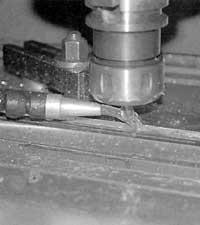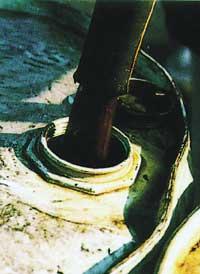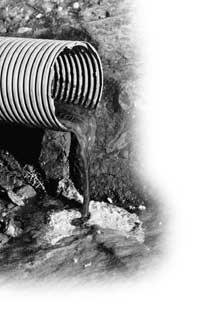Drills
1998/09/01 Etxaide, Maider Iturria: Elhuyar aldizkaria

Drills are products commonly used in machining processes to reduce friction and cooling between the tool and the part in manufacture. The metal processing industry is the largest consumer of this type of fluid, although it is also used by small workshops, since it is normal that they are equipped with machine tools.
Drills are oil and water mixtures basically. Different functions to this base (antioxidants, bactericides, moisturizers, emulsifiers, etc.) additives containing are added. Oil is the most important component of drills, with lubricating function. Three types of drills are distinguished according to the quantity and quality of the material: oil emulsions, synthetic drills and semi-synthetic drills. In the former, mineral or vegetable oils constitute 60-80% of the mixture, 40-60% of synthetic drills are water and in them there is no mineral oil, 20-50% of semi-synthetic drills are water and 10-40% mineral or synthetic oil.
Additives are added to the base mixture depending on the desired result. As a result, drills are obtained from different formulations, with characteristics to control. Among the additives used are sulfonates (emulsifiers), nitrites and amines (anticorrosives), alcohols and phosphates (moisturizers), formoles and phenols (biocides), silicones (antifoams), dyes and heavy metals.
Drills, malignant residue
The personnel who use drills in their daily work are the ones who suffer the most damage. Thaladrins produce health effects on three levels: skin, airways, and cancer. On the one hand, oils and some additives produce dermatitis. On the other hand, chlorinated additives and oils cause clinical acne and melanosis respectively, skin diseases.

In addition, the oil particles that pass into the air in the machining processes produce irritation of the airways when they reach the lungs of the operator. However, the most terrible impact of drills is probably cancer: polycyclic aromatic hydrocarbons present in mineral oils and nitrosamines generated by nitrites and corrosion inhibiting amines are the main cause of this disease.
As already indicated, the use of drills is losing its characteristics and at a given time it is necessary to remove them to ensure the quality of the process. Then they are said to be exhausted. As one of the main components of taladrine is water, it has always been considered that it can be poured anywhere. However, the dumping of these substances, even in small quantities, can have a significant impact on both sewage treatment plants and rivers and streams. Heavy metals that contain, for example, do not disappear, as they appear accumulated in the sludge after purification. If the drills pour directly into the rivers, they kill the local fish fauna and degrade the aquatic ecosystem.
Therefore, they will be treated as hazardous waste in the used drill. This means that they should not be mixed with other substances, such as other types of oils, and delivered to an authorized manager.
Improve the management of hazardous drills

In daily work and in order to reduce the use of drills, there are ways such as avoiding spills and splashes, properly collecting the liquid that pour the parts impregnated with taladrina and measures and systems that extend the life of the taladrina (control of the quality of the bathrooms, storage of the containers in appropriate conditions, control of the polluting elements, etc.) use. In
general, the knowledge of the components of the drills and the guarantee that once exhausted they receive an adequate treatment, are basic standards for everyone who works in a company and especially for those responsible.
In any case, the best way to avoid waste generation is to eliminate hazardous substances from the production process and apply clean technologies and products. There are already systems on the market that incorporate new technologies, vegetable oils substituting mineral oils and substances substituting dangerous additives. It is very interesting to know them and start using them as much as possible.

Gai honi buruzko eduki gehiago
Elhuyarrek garatutako teknologia





